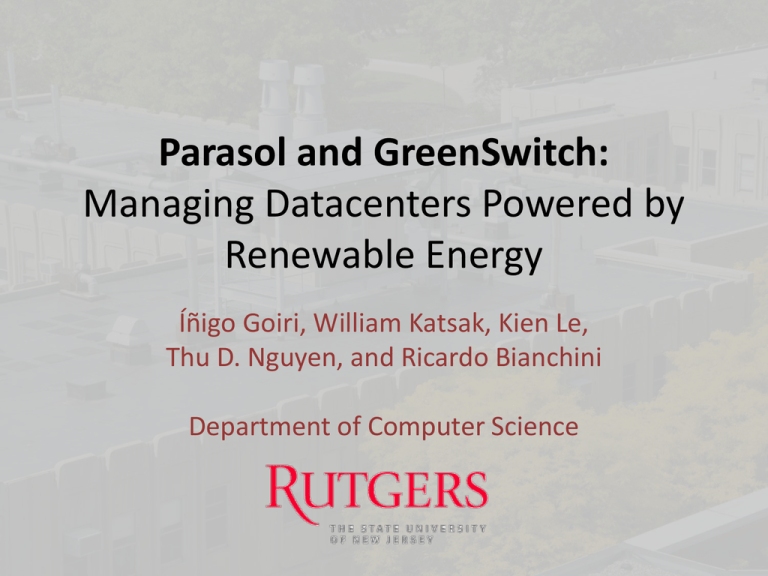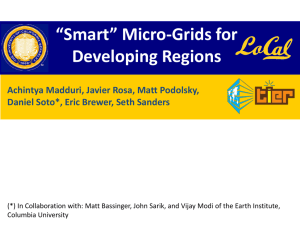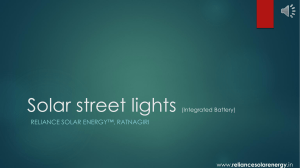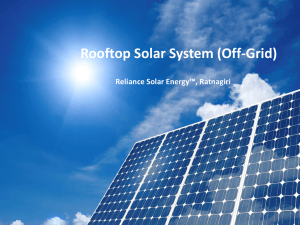Slides - Computer Science
advertisement

Parasol and GreenSwitch: Managing Datacenters Powered by Renewable Energy Íñigo Goiri, William Katsak, Kien Le, Thu D. Nguyen, and Ricardo Bianchini Department of Computer Science Motivation • Datacenters consume large amounts of energy • High energy cost and carbon footprint – Brown electricity: coal and natural gas • Connect datacenters to green sources: solar, wind Apple DC in Maiden, NC 40MW solar farm 2 Challenges and opportunities Variable Solar power Storage? Load Power Workload Time Source? • Scheduling workload/energy sources – Lower costs: brown energy, peak brown power, capital • Study opportunities in green datacenters – Build hardware/software 3 Outline • Motivation • Parasol – Solar-powered micro-datacenter • GreenSwitch – Manage workload and energy sources • GreenSwitch results • Conclusion 4 Parasol 16 solar panels: 3.2kW 2 inverters: DC→AC 16 lead-acid batteries: 32kWh 2 charge controllers: Off-grid, DC↔AC Installed on the roof • Steel structure • Small container IT equipment • 2 racks • 64 Atom servers • 2 switches • 3 PDUs 5 Electrical infrastructure DC Inverter AC Electrical Panel AC AC AC Power grid Charge Controller DC IT Equipment 6 Power Example energy source management DC Inverter Time AC Electrical Panel AC AC AC Power grid Charge Controller DC IT Equipment 7 Power Example energy source management DC Inverter Time AC Electrical Panel AC AC AC Power grid Charge Controller DC IT Equipment 8 Power Example energy source management DC Inverter Time AC Electrical Panel AC AC AC Power grid Charge Controller DC IT Equipment 9 Possible energy source management Power Basic Time 10 GreenSwitch • Minimize brown electricity cost – Brown energy – Peak brown power – Battery lifetime constraint GreenSwitch • Manage energy sources – Use solar/net metering – Charge/discharge battery – Limit brown peak power • Manage workload Get status Perform changes Parasol – Turn servers on/off – Delay deferrable jobs 11 GreenSwitch architecture Battery Charge Level Energy Source Schedule Solver Configurer Workload Prediction Energy Availability Prediction Solar Brown Price Workload Schedule Model & MILP Workload Time Power Power Predictor GreenSwitch Workload Time Parasol Use solar to power all servers Charge battery with surplus solar 12 Experimental environment • Evaluation on 64 Parasol nodes – 12 one-day experiments – Deferrable vs. non-deferrable workloads – Baseline datacenter (no solar, no batteries, no delays) • New Jersey brown electricity pricing – On/off-peak energy, peak power, net metering • GreenSwitch for Hadoop (configurer) 13 Experimental environment IT load SWIM: Facebook based workload [MASCOTS’11] 14 Parasol without GreenSwitch Green available IT load Net metering Green use Brown use 66% cost savings → Solar amortized in 7 years 15 GreenSwitch: non-deferrable workload Green available IT load Battery charge Battery discharge Peak grid power Green use Brown use 75% cost savings → Batteries cannot be amortized 16 GreenSwitch: deferrable workload Green available Net metering Battery charge IT load Battery discharge Green use 96% cost savings → Solar + batteries amortized in 7.6 years 17 Parasol: a real system • • • • Real software running on real hardware Power losses Overhead of energy source switching System limitations – Net metering vs. Battery charging – Use brown vs. Net metering – Green battery charging vs. Use brown 18 Conclusions • Green datacenters – Challenges & opportunities – Hardware/software solution • GreenSwitch benefits – Delaying load and solar gives the best results – Reduces amortization time by 1.8-2x – Flexibility: no batteries, workloads, wind… 19 Parasol and GreenSwitch: Managing Datacenters Powered by Renewable Energy Íñigo Goiri, William Katsak, Kien Le, Thu D. Nguyen, and Ricardo Bianchini http://parasol.cs.rutgers.edu • Fewer conversions – Grid-tie: AC→DC • Low conversion losses • Commodity hardware – Availability – Cheaper • Cheaper transmission 21 Parasol: lessons learned • Not cheap – Flexibility adds complexity and cost – Placement on the roof – Full monitoring • Not easy – Complete design – Dealing with facilities, companies, and vendors – Mistakes are easy – Delays, delays, and more delays 22 Viability of green datacenters • Example companies investing in self-generation – Apple, Microsoft, McGraw-Hill • Research shows cost savings • Getting more attractive – Space: Solar panels are getting more efficient – Cost: 7x cheaper than 30 years ago – Governmental Incentives • Grid-centric: power purchase agreement – Losses, dependence, long term scalability 23 Other results • Energy storage – Batteries – Net metering pricing • Peak grid power charges • Solar availability – Cloudy, sunny, rainy… • Other workloads – Nutch • Grid outage 24









